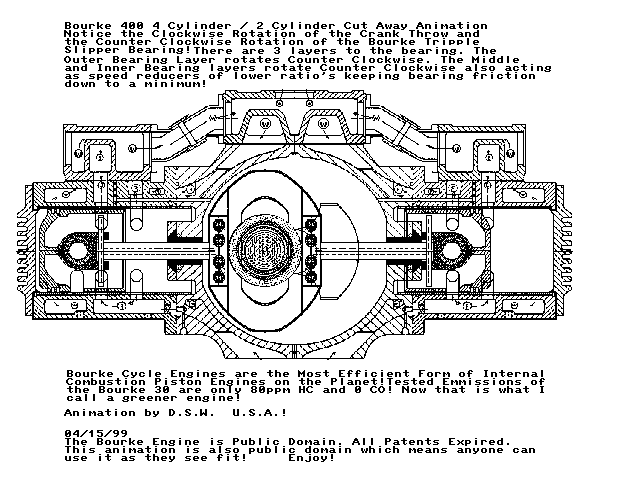Hello!
I see there are several posts throughout this forum regarding the Bourke Engine. I am happy to see there is an interest with regard to other possible applications.
The scotch yoke bottom end (crankcase) was specifcally designed to allow for perfect sinusoidal operation. Russell Bourke spent many years figuring out just what the perfect ratio and geometry was for the reverse cam effect scotch yoke design which had been around for decades before his research began in the late 1940's.
The primary difference and what makes the Bourke scotch yoke design unique is that Russell Bourke was the first in history to figure out the correct and best way to use the scotch yoke in reverse.
Prior to that time, the scotch yoke mechanism was used to multiply the torque input at the shaft (crankshaft) into pressure many times greater than otherwise needed to produce work.
After Russell figured out what the best ratio/geometry was, he then discovered imperically a much more efficient way to convert thermal energy into torque (horsepower) from hydrocarbon fuels. This discovery was not simply stumbled upon. It was Russell's primary goal. The 'Bourke Cycle' was born!
More efficient conversion of hydrocarbon fuels to squeeze maximum power out of a pound of fuel than conventional engines could. Russell knew way back then that if engines were not drastically improved upon, many nagative effects on our environment and man kind himself would be suffered. We are now suffering those consequences today in more ways that Russell invisioned back in the 1950's!
The Bourke engine is still to this day valuable and can still make the positive changes that he designed his engine to perform if put to use! It would be a wonderful engine to convert other fuels such as HHO into super efficient rotary power!
Evidently, many on this forum feel that the scotch yoke mechanism itself has other applications and advantages. I agree!
David Wolfe
Founder
The Bourke Engine! A Step In The Right Direction!
Project Bourke Engine! Now We're Gettin Somewhere!
I see there are several posts throughout this forum regarding the Bourke Engine. I am happy to see there is an interest with regard to other possible applications.
The scotch yoke bottom end (crankcase) was specifcally designed to allow for perfect sinusoidal operation. Russell Bourke spent many years figuring out just what the perfect ratio and geometry was for the reverse cam effect scotch yoke design which had been around for decades before his research began in the late 1940's.
The primary difference and what makes the Bourke scotch yoke design unique is that Russell Bourke was the first in history to figure out the correct and best way to use the scotch yoke in reverse.
Prior to that time, the scotch yoke mechanism was used to multiply the torque input at the shaft (crankshaft) into pressure many times greater than otherwise needed to produce work.
After Russell figured out what the best ratio/geometry was, he then discovered imperically a much more efficient way to convert thermal energy into torque (horsepower) from hydrocarbon fuels. This discovery was not simply stumbled upon. It was Russell's primary goal. The 'Bourke Cycle' was born!
More efficient conversion of hydrocarbon fuels to squeeze maximum power out of a pound of fuel than conventional engines could. Russell knew way back then that if engines were not drastically improved upon, many nagative effects on our environment and man kind himself would be suffered. We are now suffering those consequences today in more ways that Russell invisioned back in the 1950's!
The Bourke engine is still to this day valuable and can still make the positive changes that he designed his engine to perform if put to use! It would be a wonderful engine to convert other fuels such as HHO into super efficient rotary power!
Evidently, many on this forum feel that the scotch yoke mechanism itself has other applications and advantages. I agree!
David Wolfe
Founder
The Bourke Engine! A Step In The Right Direction!
Project Bourke Engine! Now We're Gettin Somewhere!





Comment